stop start Lancia Ypsilon 2001 Owner handbook (in English)
[x] Cancel search | Manufacturer: LANCIA, Model Year: 2001, Model line: Ypsilon, Model: Lancia Ypsilon 2001Pages: 191, PDF Size: 2.45 MB
Page 80 of 191
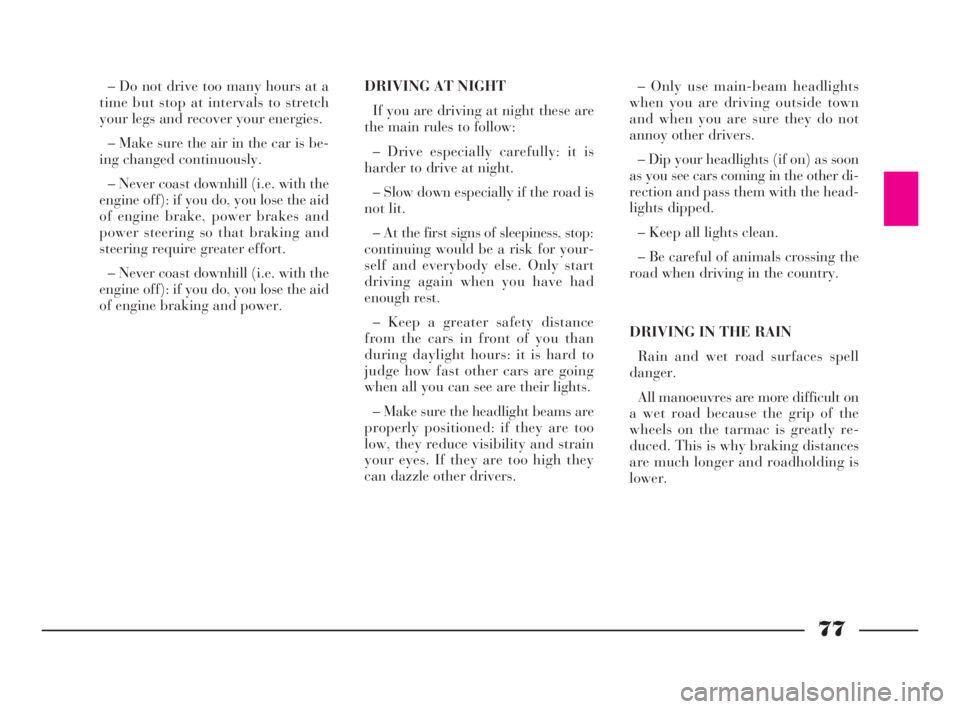
77
G
– Only use main-beam headlights
when you are driving outside town
and when you are sure they do not
annoy other drivers.
– Dip your headlights (if on) as soon
as you see cars coming in the other di-
rection and pass them with the head-
lights dipped.
– Keep all lights clean.
– Be careful of animals crossing the
road when driving in the country.
DRIVING IN THE RAIN
Rain and wet road surfaces spell
danger.
All manoeuvres are more difficult on
a wet road because the grip of the
wheels on the tarmac is greatly re-
duced. This is why braking distances
are much longer and roadholding is
lower. DRIVING AT NIGHT
If you are driving at night these are
the main rules to follow:
– Drive especially carefully: it is
harder to drive at night.
– Slow down especially if the road is
not lit.
– At the first signs of sleepiness, stop:
continuing would be a risk for your-
self and everybody else. Only start
driving again when you have had
enough rest.
– Keep a greater safety distance
from the cars in front of you than
during daylight hours: it is hard to
judge how fast other cars are going
when all you can see are their lights.
– Make sure the headlight beams are
properly positioned: if they are too
low, they reduce visibility and strain
your eyes. If they are too high they
can dazzle other drivers. – Do not drive too many hours at a
time but stop at intervals to stretch
your legs and recover your energies.
– Make sure the air in the car is be-
ing changed continuously.
– Never coast downhill (i.e. with the
engine off): if you do, you lose the aid
of engine brake, power brakes and
power steering so that braking and
steering require greater effort.
– Never coast downhill (i.e. with the
engine off): if you do, you lose the aid
of engine braking and power.
4C068-089 ING 11-03-2008 11:59 Pagina 77
Page 81 of 191
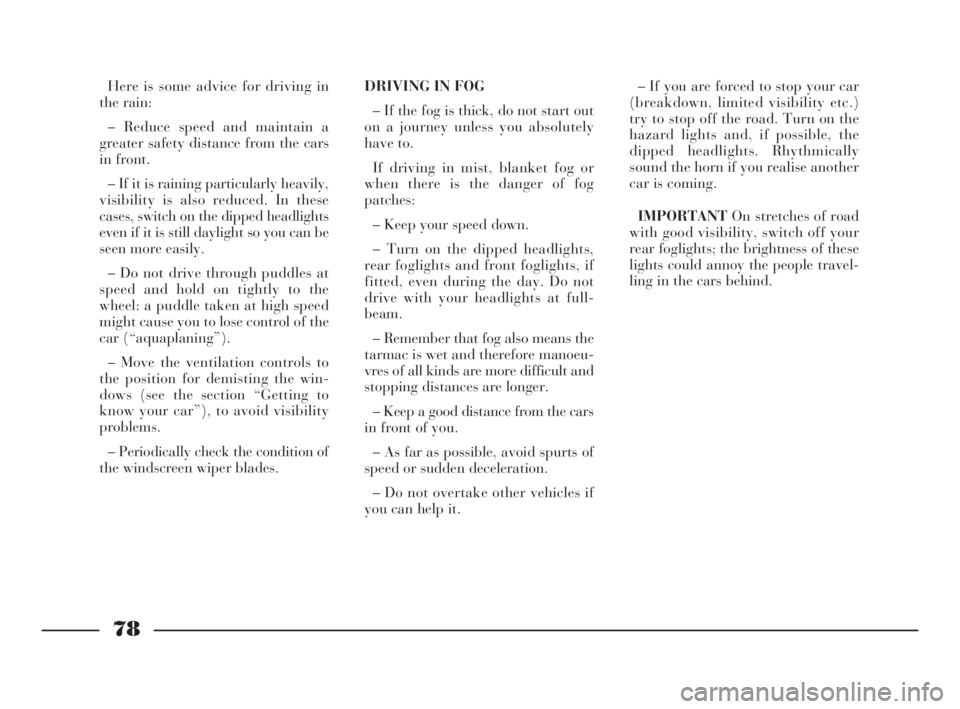
78
G
Here is some advice for driving in
the rain:
– Reduce speed and maintain a
greater safety distance from the cars
in front.
– If it is raining particularly heavily,
visibility is also reduced. In these
cases, switch on the dipped headlights
even if it is still daylight so you can be
seen more easily.
– Do not drive through puddles at
speed and hold on tightly to the
wheel: a puddle taken at high speed
might cause you to lose control of the
car (“aquaplaning”).
– Move the ventilation controls to
the position for demisting the win-
dows (see the section “Getting to
know your car”), to avoid visibility
problems.
– Periodically check the condition of
the windscreen wiper blades.DRIVING IN FOG
– If the fog is thick, do not start out
on a journey unless you absolutely
have to.
If driving in mist, blanket fog or
when there is the danger of fog
patches:
– Keep your speed down.
– Turn on the dipped headlights,
rear foglights and front foglights, if
fitted, even during the day. Do not
drive with your headlights at full-
beam.
– Remember that fog also means the
tarmac is wet and therefore manoeu-
vres of all kinds are more difficult and
stopping distances are longer.
– Keep a good distance from the cars
in front of you.
– As far as possible, avoid spurts of
speed or sudden deceleration.
– Do not overtake other vehicles if
you can help it.– If you are forced to stop your car
(breakdown, limited visibility etc.)
try to stop off the road. Turn on the
hazard lights and, if possible, the
dipped headlights. Rhythmically
sound the horn if you realise another
car is coming.
IMPORTANTOn stretches of road
with good visibility, switch off your
rear foglights; the brightness of these
lights could annoy the people travel-
ling in the cars behind.
4C068-089 ING 11-03-2008 11:59 Pagina 78
Page 85 of 191

82
G
Gear selection
As soon as the traffic and road con-
ditions allow it, shift to a higher gear.
Using a lower gear to liven up accel-
eration greatly increases consumption.
In the same way, improper use of the
higher gears will increase consump-
tion, emissions and wear and tear on
the engine.
Top speeds
Fuel consumption increases consid-
erably as speed increases. For exam-
ple, when accelerating from 90 to
120 kph, fuel consumption increases
by about +30%. Your speed should
be kept as even as possible and su-
perfluous braking and acceleration
avoided as this increases both con-
sumption and emissions. A “soft” way
of driving should be adopted by at-
tempting to anticipate manoeuvres to
avoid imminent danger and to keep a
safe distance from the vehicle in front
in order to avoid braking sharply.Acceleration
Accelerating violently increasing the
revs will greatly affect consumption
and emissions: acceleration should be
gradual and not exceed the maximum
torque.
CONDITIONS OF USE
Cold starting
Frequent cold starting will not en-
able the engine to reach optimal run-
ning temperature. It follows therefore
that consumption will be higher (from
+15% to +30% in built-up areas) as
will the production of toxic emissions. STYLE OF DRIVING
Starting
Do not warm the engine when the
car is stationery or at high or low revs:
in this way the engine will warm up
gradually increasing consumption and
emissions. You should drive off slowly
straight away avoiding high revs so
that the engine will warm up more
quickly.
Unnecessary actions
Avoid revving the engine when
stopped at traffic lights or before
switching off the engine and avoid
doubling the clutch as these actions
have no purpose on modern vehicles
and serve only to increase consump-
tion and pollution.
4C068-089 ING 11-03-2008 11:59 Pagina 82
Page 94 of 191

91
G
EMERGENCY
STARTUP
If the ignition key fails to deactivate
the engine immobiliser, the warning
light¢will remain lit and the engine
will not start. In this case, you should
contact your LANCIA Dealership
and get them to carry out the emer-
gency startup using the code given on
the CODE card. Alternatively, you
can perform the emergency startup
procedure yourself by following the
procedure given below.
Read the whole procedure care-
fully before trying to carry it out.If
you make a mistake in the emergency
procedure you must turn the ignition
key back to STOPand repeat the
whole operation from the beginning
step1.
1)Read the 5-figure electronic code
given on the CODE card.
2)Turn the ignition key to MAR.
3)Press the accelerator pedal to the
floor and keep it there. The warning
lamp will light up for about 8
seconds, and then go out. At this point
release the accelerator pedal and pre-
pare to count the number of flashes of
the warning lamp .
4)The warning lamp starts
flashing: when it has
flashed the number of times that cor-
responds to the first figure of the code
on the CODE card, press the acceler-
ator pedal and keep it there until the
warning lamp lights up for four
seconds and then
goes out again. Release the accelera-
tor pedal.
5)The warning lamp will start
flashing again: when
the lamp has flashed the number of
times that corresponds to the second
figure on the CODE card, press the
accelerator pedal to the floor and keep
it there.
6)Do the same for the remaining
figures on the CODE card.
7)Once the final figure has been en-
tered, keep the accelerator pedal
pressed. The warning lamp will
light up for 4 seconds andthen go out. Release the accelerator
pedal.
4C090-119 ING 11-03-2008 12:00 Pagina 91
Page 95 of 191
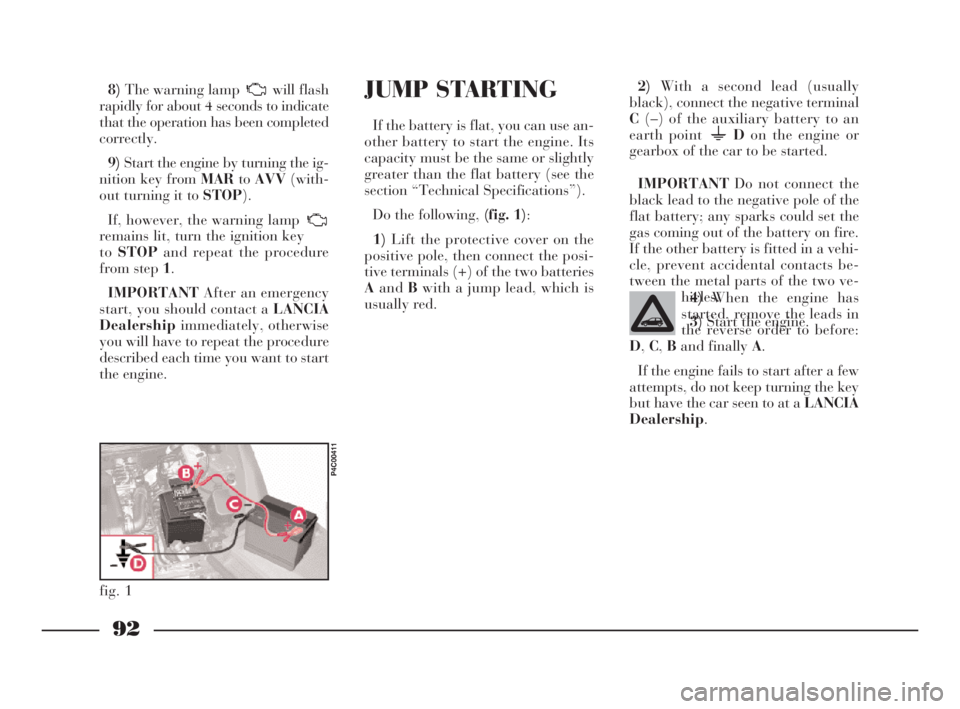
92
G
8)The warning lamp will flash
rapidly for about 4 seconds to indicate
that the operation has been completed
correctly.
9)Start the engine by turning the ig-
nition key from MARtoAVV(with-
out turning it to STOP).
If, however, the warning lamp
remains lit, turn the ignition key
toSTOPand repeat the procedure
from step 1.
IMPORTANTAfter an emergency
start, you should contact a LANCIA
Dealershipimmediately, otherwise
you will have to repeat the procedure
described each time you want to start
the engine.JUMP STARTING
If the battery is flat, you can use an-
other battery to start the engine. Its
capacity must be the same or slightly
greater than the flat battery (see the
section “Technical Specifications”).
Do the following, (fig. 1):
1)Lift the protective cover on the
positive pole, then connect the posi-
tive terminals (+) of the two batteries
AandBwith a jump lead, which is
usually red.2)With a second lead (usually
black), connect the negative terminal
C(–) of the auxiliary battery to an
earth point Don the engine or
gearbox of the car to be started.
IMPORTANTDo not connect the
black lead to the negative pole of the
flat battery; any sparks could set the
gas coming out of the battery on fire.
If the other battery is fitted in a vehi-
cle, prevent accidental contacts be-
tween the metal parts of the two ve-
hicles.
3)Start the engine.
4)When the engine has
started, remove the leads in
the reverse order to before:
D,C,Band finally A.
If the engine fails to start after a few
attempts, do not keep turning the key
but have the car seen to at a LANCIA
Dealership.
fig. 1
P4C00411
4C090-119 ING 11-03-2008 12:00 Pagina 92
Page 131 of 191
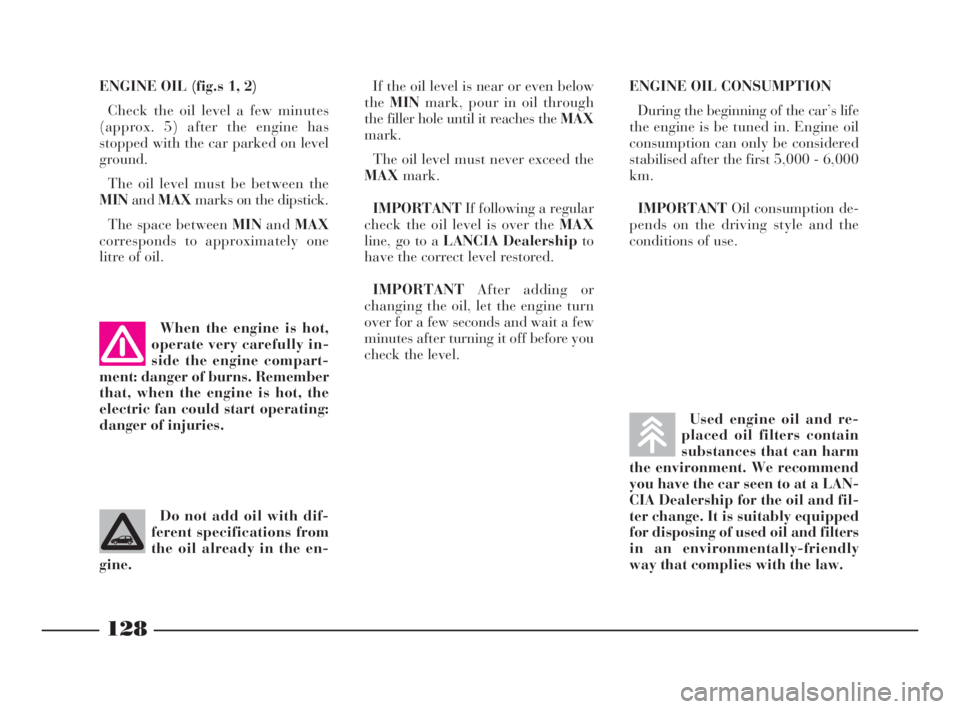
128
G
ENGINE OIL (fig.s 1, 2)
Check the oil level a few minutes
(approx. 5) after the engine has
stopped with the car parked on level
ground.
The oil level must be between the
MINandMAXmarks on the dipstick.
The space between MINandMAX
corresponds to approximately one
litre of oil.If the oil level is near or even below
theMINmark, pour in oil through
the filler hole until it reaches the MAX
mark.
The oil level must never exceed the
MAXmark.
IMPORTANTIf following a regular
check the oil level is over the MAX
line, go to a LANCIA Dealershipto
have the correct level restored.
IMPORTANTAfter adding or
changing the oil, let the engine turn
over for a few seconds and wait a few
minutes after turning it off before you
check the level.ENGINE OIL CONSUMPTION
During the beginning of the car’s life
the engine is be tuned in. Engine oil
consumption can only be considered
stabilised after the first 5,000 - 6,000
km.
IMPORTANTOil consumption de-
pends on the driving style and the
conditions of use.
When the engine is hot,
operate very carefully in-
side the engine compart-
ment: danger of burns. Remember
that, when the engine is hot, the
electric fan could start operating:
danger of injuries.
Do not add oil with dif-
ferent specifications from
the oil already in the en-
gine.
Used engine oil and re-
placed oil filters contain
substances that can harm
the environment. We recommend
you have the car seen to at a LAN-
CIA Dealership for the oil and fil-
ter change. It is suitably equipped
for disposing of used oil and filters
in an environmentally-friendly
way that complies with the law.
4C120-143 ING 11-03-2008 12:01 Pagina 128
Page 182 of 191
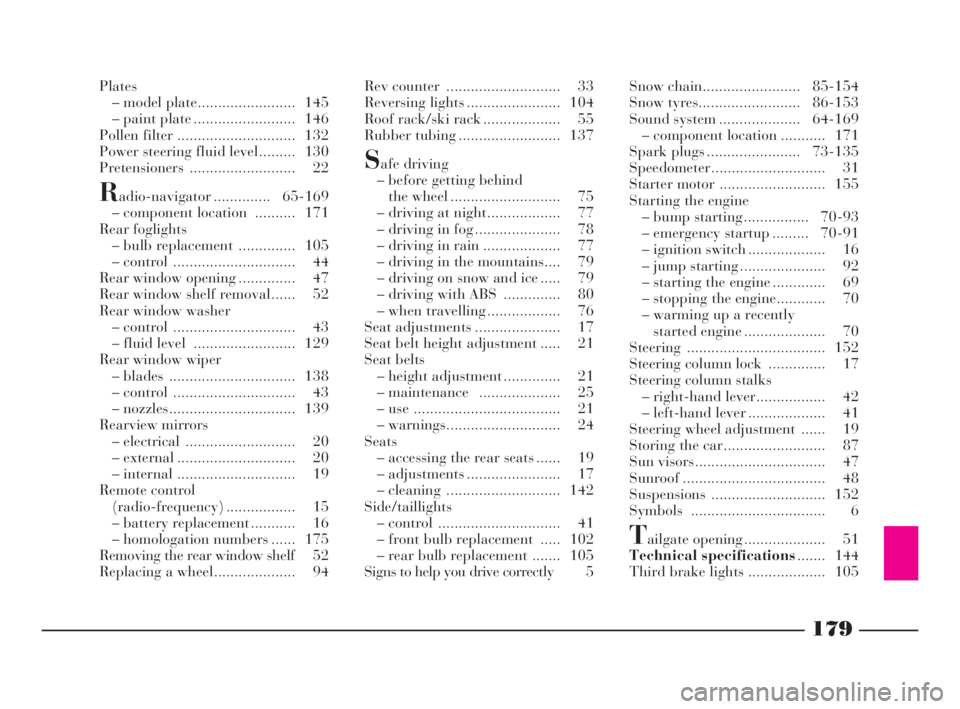
179
fdG
Plates
– model plate........................ 145
– paint plate ......................... 146
Pollen filter ............................. 132
Power steering fluid level......... 130
Pretensioners .......................... 22
Radio-navigator .............. 65-169
– component location .......... 171
Rear foglights
– bulb replacement .............. 105
– control .............................. 44
Rear window opening .............. 47
Rear window shelf removal...... 52
Rear window washer
– control .............................. 43
– fluid level ......................... 129
Rear window wiper
– blades ............................... 138
– control .............................. 43
– nozzles............................... 139
Rearview mirrors
– electrical ........................... 20
– external ............................. 20
– internal ............................. 19
Remote control
(radio-frequency) ................. 15
– battery replacement ........... 16
– homologation numbers ...... 175
Removing the rear window shelf 52
Replacing a wheel.................... 94Rev counter ............................ 33
Reversing lights ....................... 104
Roof rack/ski rack ................... 55
Rubber tubing ......................... 137
Safe driving
– before getting behind
the wheel ........................... 75
– driving at night.................. 77
– driving in fog ..................... 78
– driving in rain ................... 77
– driving in the mountains.... 79
– driving on snow and ice ..... 79
– driving with ABS .............. 80
– when travelling .................. 76
Seat adjustments ..................... 17
Seat belt height adjustment ..... 21
Seat belts
– height adjustment .............. 21
– maintenance .................... 25
– use .................................... 21
– warnings............................ 24
Seats
– accessing the rear seats ...... 19
– adjustments ....................... 17
– cleaning ............................ 142
Side/taillights
– control .............................. 41
– front bulb replacement ..... 102
– rear bulb replacement ....... 105
Signs to help you drive correctly 5Snow chain........................ 85-154
Snow tyres......................... 86-153
Sound system .................... 64-169
– component location ........... 171
Spark plugs ....................... 73-135
Speedometer............................ 31
Starter motor .......................... 155
Starting the engine
– bump starting ................ 70-93
– emergency startup ......... 70-91
– ignition switch ................... 16
– jump starting ..................... 92
– starting the engine ............. 69
– stopping the engine............ 70
– warming up a recently
started engine .................... 70
Steering .................................. 152
Steering column lock .............. 17
Steering column stalks
– right-hand lever................. 42
– left-hand lever ................... 41
Steering wheel adjustment ...... 19
Storing the car......................... 87
Sun visors................................ 47
Sunroof ................................... 48
Suspensions ............................ 152
Symbols ................................. 6
Tailgate opening .................... 51
Technical specifications....... 144
Third brake lights ................... 105
4C177-184 Indice ING 13-03-2008 13:31 Pagina 179